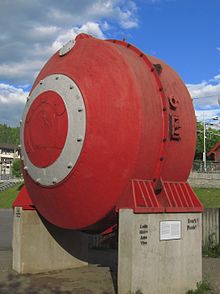伯克兰-艾德法

伯克兰-艾德法(挪威語:Birkeland-Eyde-prosessen,英語:Birkeland–Eyde process)曾是化学工业中一种硝酸的制备方法,主要用于氮肥生产。它是一种由多个步骤组成的固氮过程:高压电弧使大气中的氮气(N2)与氧气(O2)在3000 °C高温中结合产生氮氧化物(NOx);二氧化氮(NO2)在水中溶解得到硝酸(HNO3);硝酸最终作为氮肥的生产原料,是硝酸盐的来源。[1]
本方法由挪威科学家克里斯蒂安·伯克兰研发[2],并与工业家山姆·艾德于1903年合作投产[2][3],建立在1780年代亨利·卡文迪什发现的化学现象的基础之上。[4][5]在哈伯法与奥斯特瓦尔德法发明后,本方法因能效低、耗电大,在1910-1920年代间逐渐淘汰。[6]
反应
[编辑]
反应装置核心是一个火花隙,因此有时也称电弧炉。它的两个电极由铜管制成,具有同轴式结构,采用水冷散热。两电极间施加电压5 kV、频率50 Hz的高压交流电,使火花隙反复快速放电[7],产生电弧。在电极周围,还使用与电极方向垂直的电磁铁施加一个静磁场,它产生的洛伦兹力会将电弧拉伸为碟形薄片。
碟片形电弧是温度大于3000 °C的等离子体。当空气吹过电弧时,在高温下,氮气氧化产生一氧化氮。在自然界中,大气中的闪电也能产生相同的化学反应,是可溶性硝酸盐的一个来源。[8]此外,原则上也可以使用火焰、电热铂导线、普通电弧作为热源——但效果不佳,不适合工业上大规模生产。伯克兰-艾德的碟片形电弧不但能与空气充分接触,还大幅提升了反应器的功率上限。用这种方法产生的碟片形电弧直径可达2米,发出太阳般的耀眼光芒。[6][7]

此反应速率在低温时非常缓慢,因此必须在高温下进行,降低温度会使产量下降。[9][10]20世纪初实验表明,温度大于2000 °C时,反应速率“极快”,但在1000 °C时却会“缓慢到难以测量”。[1]通过精心控制电弧的能量与气流的流速,在3000 °C时可产生4%-5%的一氧化氮。本反应能耗极高,生产一吨硝酸需要消耗15兆瓦时(15,000千瓦时)的电能,1kWh电能仅能生产60g硝酸。伯克兰的化工厂供电需要依靠附近的水力发电厂。[9][10]
高温一氧化氮随后冷却,与大气中的氧产生二氧化氮。此反应所需时间取决于空气中NO的浓度,浓度为1%时需要180秒,浓度为6%时需要40秒,产率为90%.[11]
接着,用水溶解二氧化氮产生硝酸。最后用分馏法进行提纯。[12]
吸收过程的设计对整个系统的效率至关重要。二氧化氮要通过一系列四层楼高的填料塔或板式塔,产生40-50%的硝酸(高于此浓度时,吸收速率骤降)。第一座吸收塔让气泡状的二氧化氮穿过水与不发生反应的石英碎片。当达到最终浓度后,硝酸会转移到一个花岗岩制成的容器中,塔中液体被第二座吸收塔中更稀的酸液替代。这个移动过程如此反复,气体与液体向相反的方向转移,最后一座吸收塔需要不断补充淡水。此时约20%的氮氧化物仍未反应,因此最末尾的吸收装置中含有碱性的石灰溶液,将剩余的氮氧化物转化为硝酸钙(又称挪威硝石),但仍有约2%的氮氧化物释放到空气中。[13]
硝酸是生产氮肥所需的硝酸盐离子NO3−的来源,化学式为:
历史
[编辑]1781年,英国化学家亨利·卡文迪什在过量空气中燃烧氢,发现产生的水中含有硝酸。1785年,卡文迪什用电火花隙进一步研究发现,如果能量与氧气供应充足,空气中的氮气可全部氧化为硝酸,但仍有约1/120的少量气体不反应。1894年,瑞利勋爵重复了卡文迪什的实验,最终与威廉·拉姆齐爵士合作发现了稀有气体氩,同时也研究了能量输入与硝酸产出的关系。[1]
为提高产量与效率,后人从大量实验中得到了一系列结论:本化学反应的本质是氮气的氧化,是需要在高温下进行的未催化吸热反应;温度应大于2000度,而且一氧化氮必须能快速冷却;原则上可以使用任何一种热源,包括火焰、铂电热丝、电弧。之所以使用电弧,是因为火焰的高温区大小有限,使空气难以充分穿过,也不能迅速开关使气体有效冷却,而铂电热丝无法在金属熔点之上工作;研究还发现使用高频交流电、高阻抗、低电流时效果最佳。低电流意味着难以提升反应器功率与产能。[1]
1902年,美国人查尔斯·S·布拉德利(Charles S. Bradley)与迪米特·R·洛夫乔伊(Dimmitt R. Lovejoy)发明了一种具有多组小电极的圆形旋转火花隙反应器,他们申请了专利,成立大气产品公司(Atmospheric Products Co.),在纽约州尼亚加拉瀑布附近建立了一家小型化工厂。两人希望用廉价的水电资源支持生产,然而公司在商业上并不成功,仅两年后就停止运作[1][14],主要原因是产能低。在挪威,刚创刊不久的《电化学工业》发表了两人的研究成果。伯克兰看到这篇文章后,认为自己的单一碟形大电弧方案要优于多个小电弧。[7]
碟形电弧装置最初由德国物理学家尤利乌斯·普吕克在1861年发明。在该实验中,普吕克在火花隙周围放置U型电磁铁,使电磁铁与电极两端方向互相垂直,得到了碟片形电弧。随后瓦尔特·能斯脱等人也重复了类似的实验。[15][16]伯克兰将其工业化,从而克服了电流限制,解决了反应器的功率问题,使大规模生产实用化。[1]使用电弧的灵感,来自他之前在实验中发生短路的线圈炮发明。[17]

挪威的两个城镇留坎、诺托登曾建有使用此工艺的化工厂,并依靠附近的水力发电厂供电。1908年,诺托登工厂的固氮产量达7000吨;留坎的化工厂则是后来建成,年产量28000吨。[14]相比后来的新方法,伯克兰-艾德法能效低、耗电大。在哈伯法与奥斯特瓦尔德法发明后,本方法在1910-1920年代间被挪威工业逐渐淘汰。今日,这两个城镇的工厂成为留坎-诺托登工业遗址,被联合国教科文组织收录于《世界遗产名录》。[18]
在现代化工中,哈伯法使氢气(H2)与大气中的氮气(N2)发生反应,转化为氨(NH3)。其中的氢气通常来自甲烷(CH4),使用蒸汽重整制备。奥斯特瓦尔德法随后将氨转化为硝酸(HNO3)。[6]
参见
[编辑]参考资料
[编辑]- ^ 1.0 1.1 1.2 1.3 1.4 1.5 Remsen, I.; Renoup, H. The Oxidation of Atmospheric Nitrogen with Reference to the Manufacture of Nitrates and Nitric Acid (PDF). American Chemical Journal. 1906, 35: 358–367 [2024-03-04].
- ^ 2.0 2.1 Lucy Jago. The Northern Lights. Knopf Doubleday Publishing Group. 2007.
Birkeland was deeply unhappy about having to share credit with Eyde, who had no part in the technical development of the idea, but he was forced to collaborate because only Eyde had access to the huge amounts of electric power that would be needed to run the furnaces.
- ^ Eyde, Sam. The Manufacture of Nitrates from the Atmosphere by the Electric Arc—Birkeland-Eyde Process. Journal of the Royal Society of Arts. 1909, 57 (2949): 568–576. JSTOR 41338647.
- ^ Cavendish, Henry. Experiments on air. Philosophical Transactions of the Royal Society of London. 1785, 75: 372–384.
- ^ Aaron John Ihde. The development of modern chemistry. Courier Dover Publications. 1984: 678. ISBN 0-486-64235-6.
- ^ 6.0 6.1 6.2 Trevor Illtyd Williams; Thomas Kingston Derry. A short history of twentieth-century technology c. 1900-c. 1950. Oxford University Press. 1982: 134–135. ISBN 0-19-858159-9.
- ^ 7.0 7.1 7.2 Lucy Jago. The Northern Lights. Knopf Doubleday Publishing Group. 2007.
More recently, two Americans, Bradley and Lovejoy, had built a small factory beside Niagara Falls to produce saltpeter at the end of 1902, but their attempt had proved too inefficient to form the basis of a new industry. A description of their furnace had been included in the first edition of a Norwegian scientific publication, Electrochem Indus-tri, launched only the previous month; Birkeland studied the drawings in the new magazine to check that his idea was different, and therefore potentially more rewarding, than theirs. He saw that they had made a myriad of tiny arcs in their furnace, while Birkeland was planning one large arc, repeated at a high rate and swept sideways by the magnetic field to make contact with as much air as possible. It would look like a circle with the shape and heat of the sun. The following Monday Eyde and Birkeland spent the morning together at the university, inspecting the strange-looking furnace and weighing each other up as potential business collaborators. The first prototype, cobbled together in a few hours, beautifully demonstrated Birkeland’s idea of using magnetism to make large electric arcs and the tremendous noise and smell it produced were persuasive testimony to its potential.
- ^ Karl Fisher; William E. Newton. G. J. Leigh , 编. Nitrogen fixation at the millennium. Elsevier. 2002: 2–3. ISBN 0-444-50965-8.
- ^ 9.0 9.1 Mellor, J. W. Modern Inorganic Chemistry. Longmans, Green and Co. 1918: 509.
- ^ 10.0 10.1 Martin, Geoffrey; Barbour, William. Industrial Nitrogen Compounds and Explosives. Crosby Lockwood and Son. 1915: 21.
- ^ Webb, H. W. Absorption of Nitrous Gases. Edward Arnold & Co. 1923: 20.
- ^ Douglas Erwin. Industrial Chemical Process Design. McGraw-Hill. 2002: 613. ISBN 0-07-137621-6.
- ^ Knox, Joseph. The Fixation of Atmospheric Nitrogen. D. Van Nostrand Company. 1914: 45-50.
- ^ 14.0 14.1 M. Kiefer, David. Capturing Nitrogen Out of the Air. Today's Chemist at Work (American Chemical Society). [2024-03-05]. ISSN 1532-4494. (原始内容存档于2021-12-04).
- ^ Plücker. Ueber die Einwirkung des Magnets auf die elektrische Entladung [On the effect of the magnet on the electric discharge]. Annalen der Physik und Chemie. 1861, 113: 249–280 [2024-03-03]. (原始内容存档于2024-03-03) (German). From p. 255: " … die Curven, welche dieselbe durchziehen, soweit die Schätzung des Auges reicht, genau die Form von Kreisbogen an[nehmen], die sämmtlich auf der die beiden Spitzen des Entladers verbindenden geraden Linie, als gemeinschaftlicher, senkrecht stehen." ( … the curves which [the luminous discharges] traverse, assume — as far as the eye can judge — exactly the form of circular arcs, all of which stand perpendicular to the same straight line that joins the two points of the electrodes.)
- ^ Worden, Edward Chauncey. Technology of Cellulose Esters 1:2. D. Van Nostrand Company. 1921: 870.
- ^ Lucy Jago. The Northern Lights. Knopf Doubleday Publishing Group. 2007.
When the ladies retired to the drawing room and the gentlemen stood around the fire, drinking whisky and smoking cigars, Birkeland approached Eyde and said, “I have the solution.” He explained that his cannon, of which Eyde was already aware through Knudsen, produced high-energy electric arcs if it short-circuited during testing—arcs exactly like bolts of lightning. Birkeland believed this faulty element of his gun design could be combined with electromagnetic furnace technology to ionize air and produce nitric acid.
- ^ Rjukan–Notodden Industrial Heritage Site. UNESCO. 2015-07-05 [2024-03-04]. (原始内容存档于2020-07-03).




